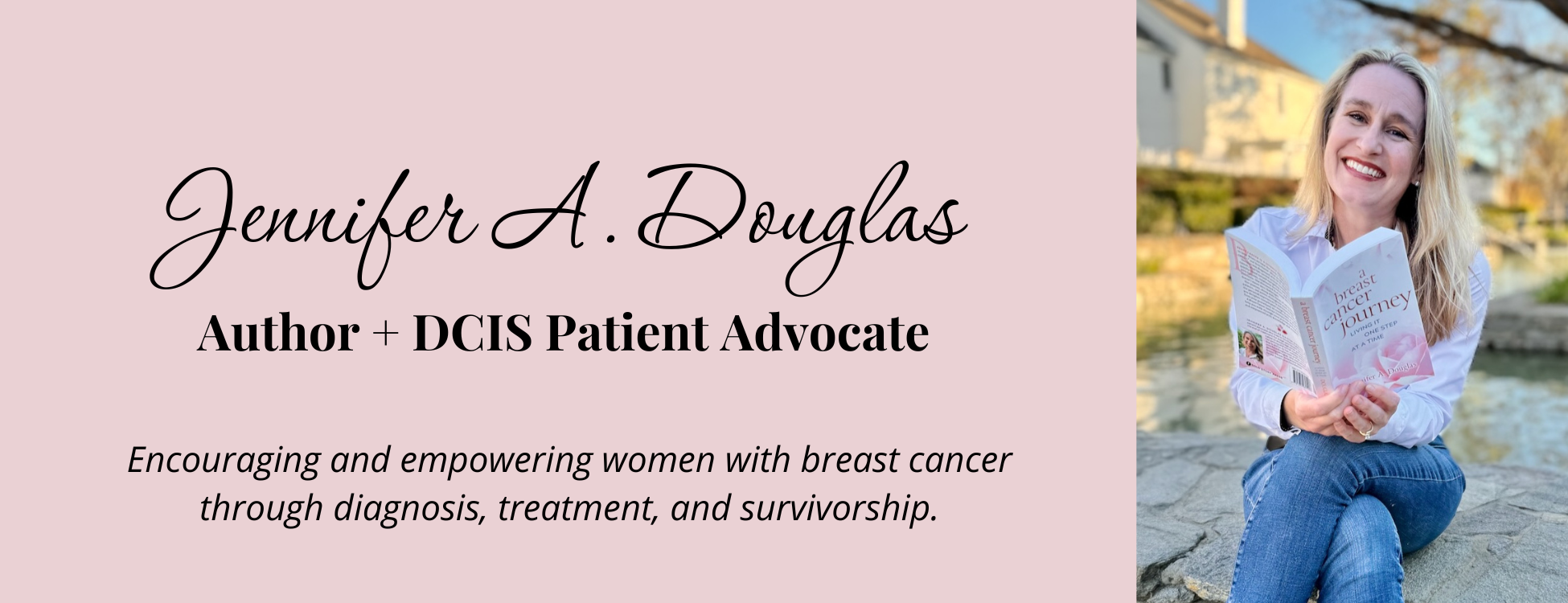
Persisting Towards a Diagnosis: From Carpal Tunnel to a Herniated Disc
I was shocked to read the MRI report from my Cervical Spine imaging. After months of ineffective treatment and incomplete diagnoses, I finally had an answer to why my left index and thumb were numb and tingling. I had a herniated disc in my cervical spine, which was pressing on the nerve root. As I inventoried my summer fun list, going to doctor appointments, getting imaging, and making time for physical therapy were not on it. And yet there I was, in my patient portal, reading another confusing MRI report.
Please Note: I’m sharing my personal experiences. I am not a doctor or medical provider. Read more on my disclaimer page.
More Adventures in Self-Advocacy
I thought that my days navigating complicated medical issues would end once my DCIS treatment was finished.
Ha! That certainly hasn’t been the case. In the two years since I was diagnosed with DCIS, there has been a global pandemic, my husband has had multiple treatments for skin cancer on his nose, and I am now dealing with a herniated disc in my spine.
Here’s how this latest medical adventure began.
Why Were my Fingers Numb?
In mid-April 2021, I was chopping up vegetables for our pasta primavera dinner when I noticed that my left index finger and thumb were tingling. That was odd. I kept chopping but wondered what was going on.
I decided to give it a few weeks and see if it resolved—no such luck. My fingers were still tingling. I had no idea why. I didn’t have chemotherapy as a part of my cancer treatment, so I wasn’t experiencing Chemo induced peripheral neuropathy. Additionally, my radiation was done on my right side, and this was my left hand.
I decided it was time to see a specialist. I looked up the hand doctor I wanted to see in my insurance portal. There was an orthopedic group that I’d seen regularly near my house with many excellent doctors.
The hand doctor didn’t show up in the insurance directory. I thought that was odd. So, I looked up my shoulder doctor. He wasn’t there either. So, I called my insurance company to see what was going on. After many phone calls, I found out that the entire orthopedic group I had seen for years was now out of network with my insurance company.
Ugh. I was frustrated because I liked these doctors, and the office was right across the street from my neighborhood. Now I needed to start over with a new provider.
Beginning the Diagnostic Process
I decided to start with my primary care doctor to see if I could get a referral. She ordered some x-rays, which showed some signs of arthritis, but nothing that would explain the numbness. She wrote out a referral to the hand specialty center, which was located in Santa Monica. Driving out would take at least an hour one way. This appointment was going to be a significant time commitment.
I made an appointment for a few weeks away. I wasn’t excited, but I thought that the wait was worth it. My phone rang a few days before my appointment. It was the nurse for the doctor I was waiting to see. It turns out he only saw patients for surgery. I wasn’t looking for a surgeon. I wanted to get a non-surgical consult.
I hung up the phone and cried. I had waited weeks for this appointment, and now it wasn’t going to happen.
I called the referral line again and was offered another appointment in a month.
I hung up the phone, frustrated and determined to find another solution.
I went online to find another hand doctor who was closer to my house and also in-network. Finally, I found one and called the office. Thankfully they could get me an appointment in three days.
I hoped this appointment was going to mean answers for me.
Hand Doctor Appointment
I arrived at the new office ready for some answers. After taking some x-rays and running some diagnostic tests, the hand doctor said that the numbness was likely due to carpal tunnel. She suggested wearing a brace at night and seeing her again in a month.
Happy to finally have a diagnosis, I drove home with a plan and another appointment set up.
I began wearing a brace at night, and it was working slightly to reduce the numbness. But, I discovered that I was waking up in the morning with an aching shoulder. My left shoulder was in pain. What was going on? Had I re-injured my shoulder?
Left Shoulder Pain- Again?
Several years ago, I impinged my shoulder and tore my labrum by carrying a heavy suitcase up some stairs while on vacation in Paris. It was an excruciating injury. I remember being up for nights in agony because I couldn’t get comfortable.
After a cortisone shot and months of physical therapy, I was able to feel better. Was it possible that I had aggravated this injury again after four years? I decided that I needed to take action right away. I began taking over-the-counter pain medicine and also decided to do my shoulder exercises again. I had saved all the printouts from physical therapy in a medical file. I pulled them out and started with the stretches and resistance band exercises.
At my follow-up appointment with the hand doctor, I discussed my fears that I had aggravated my shoulder. She ran some tests and ordered some X-rays. It appeared that I was right. I asked her for a cortisone shot and also a referral to physical therapy. Hopefully, I would get some relief. I also needed to find another shoulder doctor because her specialty was hands.
She was happy to write out the physical therapy referral and also gave me a cortisone shot. I left the office feeling pain-free and hopeful.
It took me another few weeks to get in at the physical therapy office. By the time I had my initial appointment, it was early July. My fingers had begun to go numb in April. This diagnosis process was not going quickly.
Physical Therapy and A Surprise Diagnosis
I showed up at my first physical therapy appointment, expecting to get a series of exercises focused on my shoulder injury. The physical therapist greeted me and had me do a few movements. Then she said something shocking.
“I don’t think the only issue is your shoulder. You have something going on in your neck. Have you had an MRI on your cervical spine?”
What? My neck? How was that possible? And what was my cervical spine?
“How can you tell?” I replied.
She explained to me that my neck movements were guarded. It was very much possible that I had two issues going on. First, my shoulder was aggravated, but there were also issues with my median nerve. Something was compressing the nerve, which was why I was experiencing numbness in my fingers. This would also explain why the brace and the shoulder exercises didn’t help.
She did some diagnostic tests and activated the numbness and tingling by pressing gently down on my head and moving my neck in specific ways. After doing the tests, she recommended I get a cervical spine MRI to see what was happening.
I left the office with exercises to do for my neck. This was not what I was expecting.
In the meantime, I began to do the neck exercises. To my great surprise, I began to feel the pain dissipate. This was progress!
What is the Cervical Spine?
Our spines are divided into three main sections: the cervical spine, the thoracic spine, and the lumbar spine. The cervical spine contains seven vertebrae and is located in our neck. The thoracic spine is our upper and mid-back and has 12 vertebrae. The lower section of the spine is the lumbar, and it can contain between 6-7 vertebrae.
The physical therapist believed that I had a problem with the nerve exiting my cervical spine between the C6-C7 vertebrae. This was likely causing my numbness. However, an MRI would be able to verify that diagnosis.
I made sure to call the imaging office as soon as I got a referral for the MRI. While I don’t enjoy MRIs, I would like to get some answers.
Cervical Spine MRI
A few weeks later, I showed up at the imaging center for my MRI. The first thing I asked was if I needed to have contrast for this MRI. I’m not a fan of IVs, and I wanted to be prepared. Thankfully, this particular MRI didn’t need contrast.
I needed to have a mesh face mask on to keep my head in place during the imaging. The mask would make sure that I didn’t move and potentially disrupt up the imaging. It felt pretty claustrophobic inside the MRI tube, so I did the best I could to breathe and stay calm. The MRI tech guided me through the imaging sequences, which sounded very different than my breast MRI.
I was happy when the scans finished, and the tech moved the table out of the tube.
My MRI results came through in the patient portal a few days later. I opened it up to discover that I did have a problem in my cervical spine. I had a herniated disc that was compressing a nerve. This was the reason I had experienced tingling in my left fingers. After months of misdiagnosis, I finally had some answers.
Meeting the Spinal Doctor
The next step was to get a consult scheduled with a spinal doctor. I didn’t want to jump straight into surgery, so I looked for an in-network non-surgical spinal specialist within my preferred medical group.
I was thrilled to get an appointment with him before my vacation in early August. Since this doctor was located in Santa Monica, I would be in for a drive, but it was worth it.
Once I arrived, I had the first half of my appointment with a fellow training under the spinal doctor. Then, the spinal doctor came in to see me.
First, the doctors discussed my diagnostic history, which I had written out beforehand. They also did some physical tests to see if there were any strength differences between my left and right side. Then they pulled up my MRI imaging to show me what was going on inside my body.
Seeing the MRI images was a part of my appointment that was quite valuable. I was able to see where the disc in my spine was compressing my nerve. There was a space for the nerve to exit the spine on my right side, but there wasn’t space on my left. My disc was bulging out and compressing the nerve root.
I felt relieved after seeing the images. There was a visible difference between the two sides of my body that explained my symptoms.
Once we were done discussing the MRI imaging, it was time to plan for treatment.
Treatment Plan for my Herniated Disc
The spinal doctor told me that the body would heal itself in about eighty percent of cases, and there was no need for surgery. I was responding well to the physical therapy, so he recommended that I continue with that.
If physical therapy didn’t continue to help, I could consider an epidural injection into my spine. This wouldn’t heal the disc, but it could help relieve the pain.
The last treatment option would be surgery.
I was hoping to avoid spinal surgery, so I was thrilled that most cases would respond well to conservative treatment.
When I asked the doctor about my nerve health, he said that a nerve conduction test- an EMG- could assess the relative health of the nerve. This test was something that needed to be scheduled in advance. I’ll share more about what that test was like in a future post.
He also referred me to a shoulder doctor. Since I was having shoulder pain on the same side, it was possible that I had multiple problems going on.
I walked out of the appointment feeling quite hopeful for my progress. The doctor was personable, knowledgeable and provided me with the information I needed to continue the recovery process.
I began feeling numb in my fingers in April of 2021. It was August, and I finally felt like I had the right medical team in place to help me heal.
Lessons in Self-Advocacy: Keep Persisting
Advocating for answers has been a time-consuming process over the last few months. To figure out why my fingers were numb, I needed to keep persisting. So when the first diagnosis and treatment of carpal tunnel didn’t fit, I chose to keep asking why.
I needed to keep asking questions and seeking more medical help. It wasn’t an easy process, but I’m so grateful that I’m finally getting the appropriate treatment.
I have a herniated disc in my neck. Nighttime bracing for carpal tunnel wasn’t a treatment for a herniated disc!
Somehow I thought that I would be done with complicated medical issues after breast cancer. Unfortunately, that hasn’t been the case! However, I’m glad that I have taken the advocacy skills that I developed during my treatment and apply them to this situation.
If you are dealing with a complicated medical challenge, please keep persisting. If one diagnosis and treatment isn’t relieving your symptoms, then go back to the doctor. Sometimes what looks like one problem might be masquerading as another.
Do you have any self-advocacy tips to share? Feel free to write them down in the comments so we can encourage each other.
Jennifer Douglas
Jennifer Douglas is an author, patient advocate, and DCIS breast cancer survivor. After navigating her own breast cancer journey in 2019, she began writing and encouraging others who were newly diagnosed. Her resources include her book, "A Breast Cancer Journey: Living It One Step at a Time," and her online support course, "Encourage: Breast Cancer and Beyond." Jennifer also actively supports patients through her online presence and direct involvement in communities and support groups, offering guidance and encouragement every step of the way.


You May Also Like

3 Keys for Dealing with Strong Emotions
August 25, 2020
Protecting and Preserving Your Well-Being
June 27, 2025
